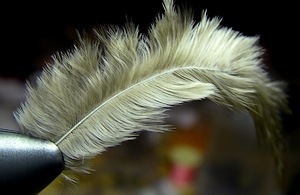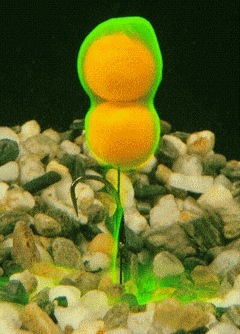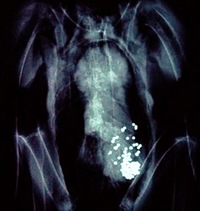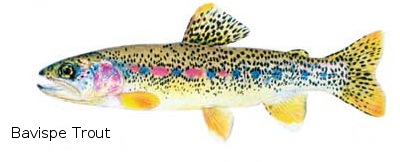Lead gray skies offered little hope so I swung by the Little Stinking to see what a week’s changes had wrought. The water was clear enough to fish but still much too high to wade – many tons of gravel have changed the entire streambed and scoured every vestige of weed and bank foliage.
With the vegetation gone the creek looks like a construction site. Barring another downpour it’ll be fishable next week.
I took advantage and banged out all my lingering chores; removing lock plates swollen by the wet and removing enough metal so the bolts once again lined up with door jambs.
The water table is being replenished, which makes the entire Central Valley rise nearly four feet. Naturally you hope your slab foundation rises with it, and every year some small thing winds up needing coaxing.
 With all the pressing chores finished I started working on the Caddis flies. I’d been sidetracked by an “old school” reference to Polly Rosborough – whose fur collared flies reminded me of Jack Gartside’s Sparrow nymph, which suggested Cal Bird’s woven bodies, and the drone of Clint Eastwood Spaghetti Westerns hummed in the background while I rediscovered my attraction to Philoplumes.
With all the pressing chores finished I started working on the Caddis flies. I’d been sidetracked by an “old school” reference to Polly Rosborough – whose fur collared flies reminded me of Jack Gartside’s Sparrow nymph, which suggested Cal Bird’s woven bodies, and the drone of Clint Eastwood Spaghetti Westerns hummed in the background while I rediscovered my attraction to Philoplumes.
Philoplumes (aftershaft feathers) are the little marabou feather attached to each pheasant body feather. They’re largely overlooked but Jack Gartside made great use of them on a lot of his flies, and were popular on the Gimp Nymph back in the 80’s.

The Gartside Sparrow uses the philoplume as the collar at the fly’s head. It’s quite delicate but offers considerable movement, and the fly is a tremendous caddis imitation. Tied in a variety of colors, using a similar shade of pheasant body as the hackle.
The original Sparrow has a tail of grizzly marabou which I omit on all but the largest sizes.
I thought I’d finished with the stoneflies, but the “Philo-urge” had me fiddling with a combination of Cal Bird’s techniques. Cal used a copper wire tail support on his steelhead flies which also added breadth to the body for woven materials.
I grabbed a hair collar from Polly, a philoplume from Gartside, and Cal’s tail and woven body to come up with flies destined for my box; it’s “tier’s prerogative” – untested intricate flies that only the creator gets to fish.

It’s not that they’ll catch more fish than anything else – they’re twice as much work as the rest of the box, so in-laws and relatives can just keep their grabby mitts off…
That was when I realized I hadn’t tied any of the patented-death stonefly nymphs that actually work. The orange and black variegated chenille monsters, complete with black rubberlegs. It’s the pattern you pass over enroute to the sexy woven body flies – thinking “if I was a fish, I’d eat those multi-colored sumbitches first.”
Huge mistake.

In the fly shop they look like Bluegill flies – when wet the orange turns brown and you’ve got mottled death on your hands.
I sure hope there’s a lot of stonefly activity this Spring, I’ve got an entire box full of shapes and colors and would be sorely put out if the fish wanted to eat the itty-bitty stuff instead.
I’m sure Carp would eat them too, so I’ll find something other than a tree branch to hang these on.

 You too can enjoy the official vineyard of the Federation of Fly Fishermen.
You too can enjoy the official vineyard of the Federation of Fly Fishermen. With the two articles sandwiched on the news page, I can’t help but wonder was there a connection. Scientists have known about the estrogen effluent story – how the sewage treatment process fails to remove hormones from reclaimed water, and fish downstream of the outflow are mostly feminine.
With the two articles sandwiched on the news page, I can’t help but wonder was there a connection. Scientists have known about the estrogen effluent story – how the sewage treatment process fails to remove hormones from reclaimed water, and fish downstream of the outflow are mostly feminine. While the rest of you debate whether it adheres to the spirit of things I’ll be quietly mixing it into my head cement. I’m preprogrammed to break ranks with the crowd at the first opportunity, exploit fish horribly, then asks forgiveness in a cataclysm of guilt.
While the rest of you debate whether it adheres to the spirit of things I’ll be quietly mixing it into my head cement. I’m preprogrammed to break ranks with the crowd at the first opportunity, exploit fish horribly, then asks forgiveness in a cataclysm of guilt.

 Statistics for California are unavailable, but Florida is a sunny state and a close approximation. There are 1,200,000 women in Florida between the ages of 18 and 29. Roughly 13% of the population bought licenses, of which the greatest single demographic (9%) was male retiree.
Statistics for California are unavailable, but Florida is a sunny state and a close approximation. There are 1,200,000 women in Florida between the ages of 18 and 29. Roughly 13% of the population bought licenses, of which the greatest single demographic (9%) was male retiree.

 Like you I received my latest fishing catalog and saw carbon rods had finally surpassed the thousand dollar price point. My thoughts on this topic are well documented, but I couldn’t help wondering – has the price of graphite made bamboo rods a bargain?
Like you I received my latest fishing catalog and saw carbon rods had finally surpassed the thousand dollar price point. My thoughts on this topic are well documented, but I couldn’t help wondering – has the price of graphite made bamboo rods a bargain?